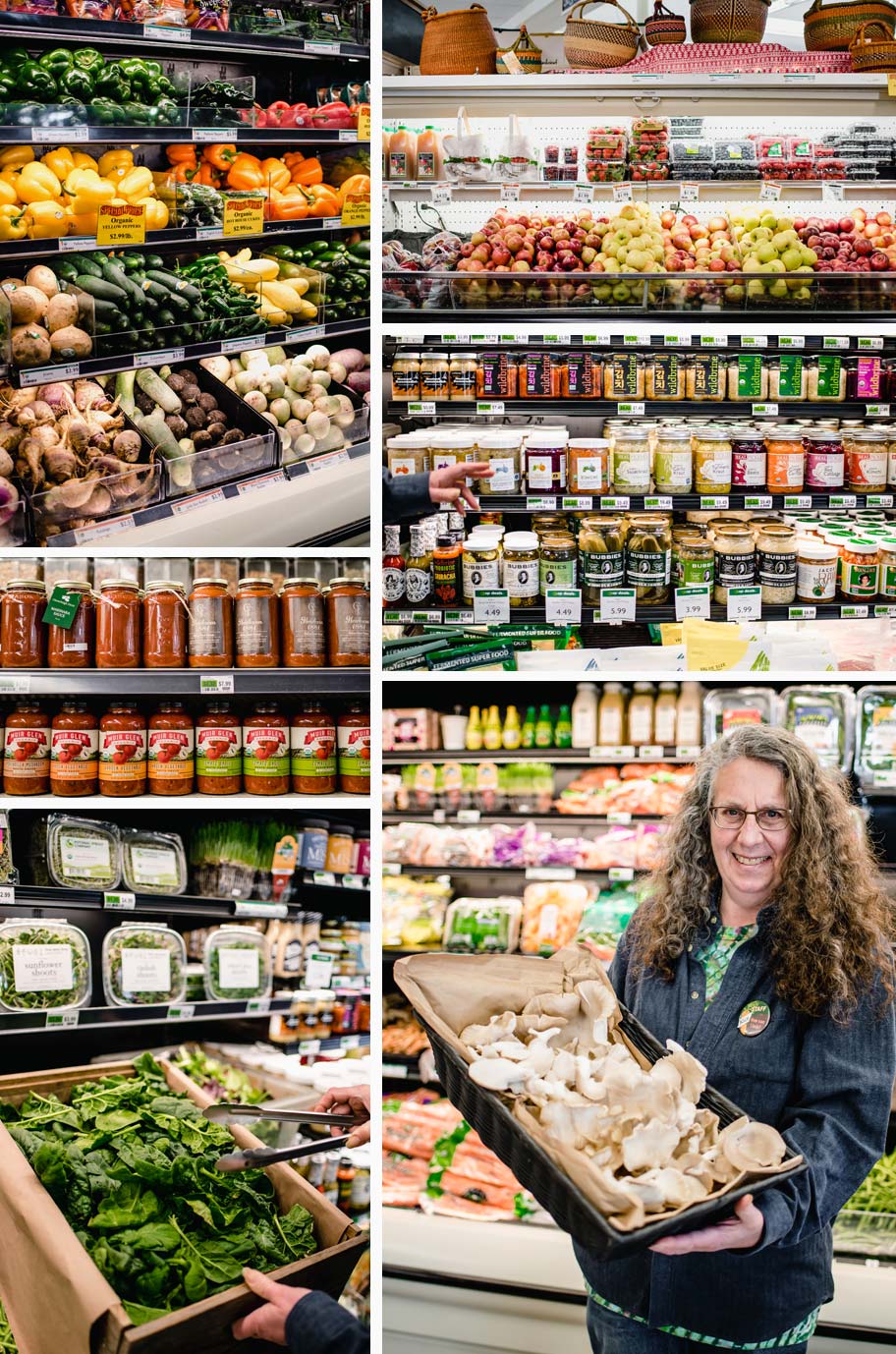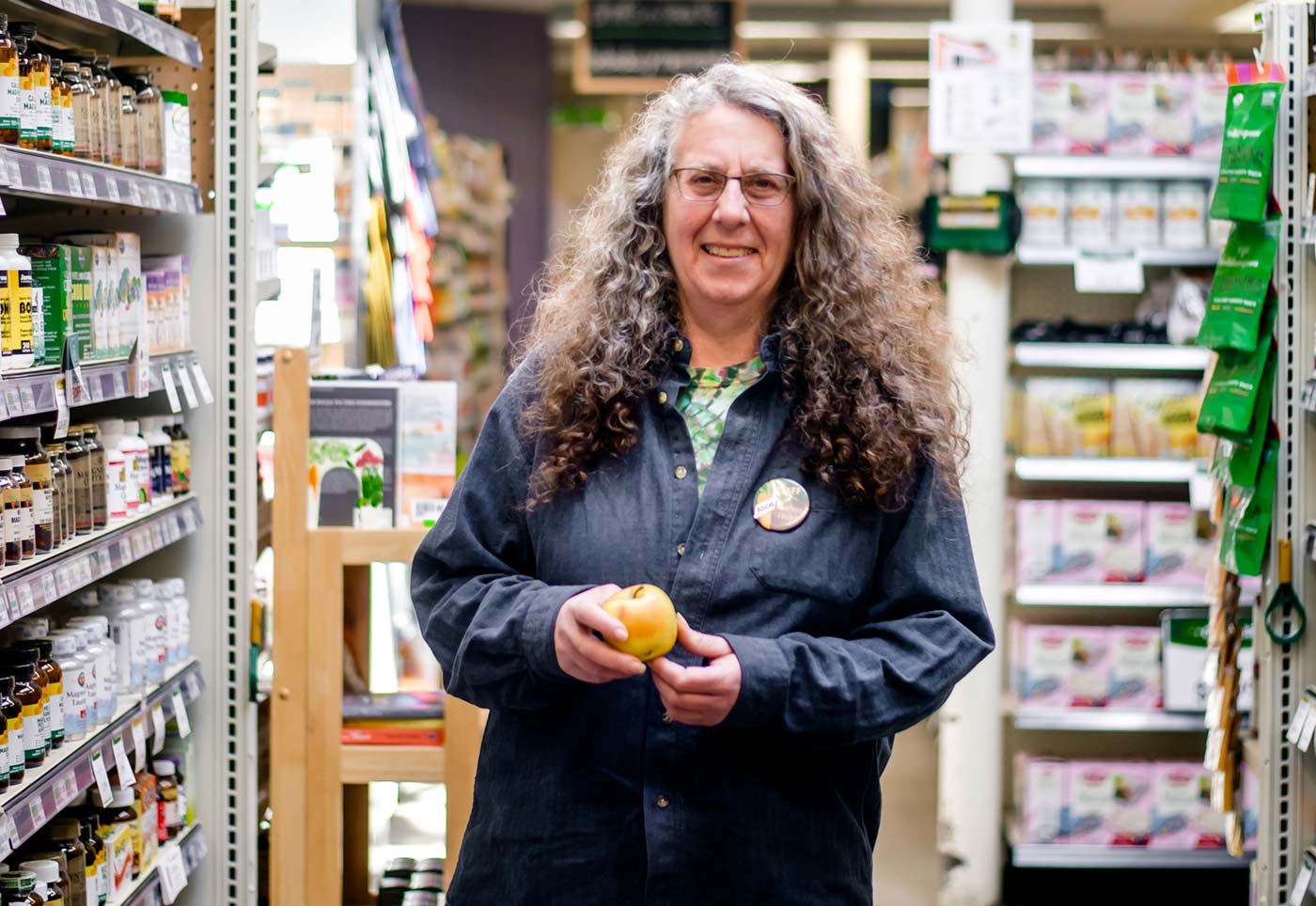Willimantic Co-op – Connecticut’s longest running cooperative market
The Willimantic Food Co-op, the state’s longest running cooperative market, celebrated its 40th birthday last year in early February with a two-day party and 40 cakes. The festivities were over and tidied up, this article had been written and photos taken, but before the issue could be published, the great wave of the pandemic crashed down on us and changed everything.
The Co-op closed their doors for three months, but they kept all their staff working, continued to purchase from suppliers, and offered email ordering and curbside pickup. Customers had to order from memory, but staff essentially became personal shoppers and did a great job in a difficult situation.
General Manager Alice Rubin has worked at the Willimantic Co-op since 1984. Despite facing many challenges over the years, she never experienced anything like this. Initially, she was scared like everyone else. “I know how to manage a grocery store--not a pandemic,” she says. “I felt a huge responsibility to keep our staff safe but to also continue to provide food for our members and revenue for our suppliers, particularly the small local ones like farmers who lost their restaurant accounts.”
Alice and Co-op leadership waded through the pandemic with the rest of the world. They set up an on-line store and eventually reopened with strict mask and social distancing policies. Initially, only staff were allowed in the popular bulk department where they filled everyone's bulk orders (recycled containers were not allowed). Restrictions gradually loosened as state mandates changed. Today, things are fairly 'normal' at the Co-op. The staff still wear masks and plexiglass barriers remain at the registers. The Co-op is still below pre-pandemic sales but numbers have been slowly rising.

The Co-op has always been on the cusp of progressive trends in food systems. This article’s original slant was “sustainability” as a vital theme. After 2020, that concept is etched with another facet of meaning. To Alice, it has become even more clear how important it is to have our community be as self-sufficient as possible.
“Sustainability is paramount,” declared Alice just before the Co-op’s 40th birthday celebration. “The Co-op’s responsibility is to owner/members who value the mission of the cooperative. The bottom line is not profit; it is delivering what members want and need. This cooperative has achieved longevity and success in part because no other retail food supplier offers sustainability on so many levels. And there are thousands of people in the region who want that.
What does sustainability look like at the Co-op? Many things, according to Alice. The Co-op provides environmental sustainability through appropriate packaging…or lack of it. “We offer as much bulk food as we can plus rebates on refilling your own containers. We sell reusable bags of all types. We even had members sew reusable produce bags that we gave away.” Economic sustainability falls under one of the cooperative’s guiding principles: autonomy and independence. “Being economically viable as a business allows us to spread our sustainability out into our community, through donations and other support so that we all can thrive,” says Rubin.
“Sustainability is purchasing as much of our inventory locally, or as close to local as we can get,” she adds. “This saves fuel in trucking, increases employment opportunities in our community, and helps preserve and maintain open space. It helps us be more self-sufficient, less reliant on people and businesses that don't have any vested interest in our community. And it provides the freshest, most nutritious food.”

The Co-op has grown steadily over 40 years. “We had almost 1,000 new members last year,” Alice says. She’s not sure if they all regularly shop there, but by investing as members they obviously see the importance of what the Co-op offers. This is despite a common perception that shopping at the Co-op is expensive.
The challenge is education. According to Alice, “We must teach consumers all of the benefits of purchasing locally grown food, all of the costs of buying imported food, and how we as a society don't value our food. We have been taught that food should be cheap--ignoring environmental and health costs.”
Since the opening of its retail store in the ‘80s, the Co-op has recognized the importance of offering locally grown products. Building relationships with local farmers, helping increase local food production, and selling fresh, high quality locally grown food has always been a goal and a big part of the Co-op’s success. Alice sees it as one of their most important responsibilities, “Not only to provide high quality food, but to do it in the most sustainable way.”
Seeing is believing. To experience sustainability in action, visit the Co-op in gritty, dynamic Downtown Willimantic. Most of the year, shoppers are greeted outside the front door by a vibrant garden of annuals: zinnias, sunflowers, cosmos, and more. They enter the Co-op into the produce department, facing a host of colors, shapes and textures, all neatly stacked, virtually free of plastic. They can touch, smell, even taste if desired. Every pile of deep green zucchini, bundle of red radishes, basket of potatoes or bin of baby spinach has a sign. “Organic, Mexico” or “Organic, California” and also “Local, unsprayed, Tobacco Road Farm” or “High Hill Orchard.” You know immediately where this food comes from.

Mark Giangrave has worked at the Co-op for 25 years. He has been the local produce buyer for about 20 years. He knows where each head of lettuce and every ruby red beet is grown. In some cases, he has stood in the field with the farmer who grew it. Over the years, Giangrave has developed and nurtured strong relationships with the local growers in eastern Connecticut to offer a wide array of healthy, delicious, fresh food in the Co-op’s produce section. Each week local growers e-mail Mark their availability. “From that I can source what we need for that week. It’s become a good system. The more we turn over our inventory the easier it gets.”
Giangrave has developed a system of vetting local growers, including paperwork and an interview and sometimes visiting the farms in person. “It’s fun to see and they are excited to have us come see what they are doing,” he says. He often knows from an initial conversation whether farmers will be compatible or not. “They have to be dedicated just to fill out the paperwork.”
For Giangrave, offering locally grown food means providing the best nutrition for the families that shop at the Co-op. He has noticed that newer shoppers often come in because of food allergies, health issues or in search of supplements. “It’s becoming mainstream that people are realizing our food systems are not high quality, not giving them the nutrition that’s necessary.” He hopes these shoppers discover the benefits of locally grown food sold at the Co-op even if it was not their first priority.
Lately, it’s been a challenge to be fair to current growers and to add new ones. The growth of new local farms has been steady, and the Co-op has gradually ordered more and more local produce. “We’ve come close to saturation here and need to expand the market for the local growers because we can only buy so much.” Giangrave has added about two to three new growers a year, some with just a few items. “We don’t want to spread it too thin or it’s not worth a farmer’s time. We need to create new markets for local food: institutions, schools, community kitchens. The money is there but infrastructure has to be invented at this point.”
Connecticut’s short growing season and working with a highly perishable product is another challenge. Where farms in California and Mexico can harvest almost year-round, local crops can be feast or famine. “You see big crops, like broccoli, come in all at once,” says Giangrave. “To stretch that over a few weeks is almost impossible.” At season’s end he must juggle what’s local and fill in with regular distributers to keep a steady supply.
Setting a price point for local produce is also challenging. “One of our greatest goals is to provide for our community,” says Alice. “We’ve done a lot of work toward the perception that we’re expensive. We’ve worked to get our prices down to be accessible for everyone.” The Co-op tries to provide local growers with as much money as possible while setting an affordable price for consumers. “We prioritize that they get what they need,” says Giangrave. “We might run a lower margin on local food so we don’t have a huge price point.” Alice adds, “We make less money so our farmers can make more and people can afford to purchase it. We all need to eat well. It’s really important.”
Most of the local growers are not certified organic. Because the Co-op knows the farmers and their methods, this seems to be a non-issue. The benefits of purchasing local supersede the benefits of organic standards. “Our priority is to source as close to home as we can get without compromising quality,” says Alice. “Certification isn’t the major player any longer until you get out of the realm of local and then it’s everything.”
Giangrave acknowledges that awareness regarding locally grown food is higher among the average shopper these days. Even the area’s big box supermarkets occasionally offer what they brand “local” produce. And it is local, but not from the small, sustainable farm in your neighborhood. Most farms in Connecticut cannot supply the volume that large supermarkets need. Alice suggests this is just marketing. “They know enough to say it’s local, but they’re not really able to do it.”
“Not everyone values food like we do,” says Alice, “But there’s a big core of people who own our store that highly value the quality of local food, that the money is kept in the community, that the land is protected and that chemicals are not used. That makes a big difference to them. We need to be able to feed ourselves. I don’t want to rely on some farm somewhere to grow the thing I want to eat and trust the trucking system to get it here. I want it to be in my neighborhood.”
2020 taught us that despite our country’s wealth, we cannot be complacent, especially when it comes to feeding our population. We have seen that sustainability is more important than ever. This is what Rubin learned this past year. “The more food we can produce locally the less we will be vulnerable to interruptions in supply. The pandemic highlighted the need for strong supplier relationships as well. Companies we have a history with are more likely to prioritize getting us what we need.” After 40 years and a worldwide tragedy, the Willimantic Co-op offers a model for the future--of a strong, local, sustainable food system that works even in difficult times.
The Willimantic Co-op is located at 91 Valley Street in Willimantic, CT. Follow on Instagram @Willimanticfoodcoop and learn more at www.willimanticfood.coop





